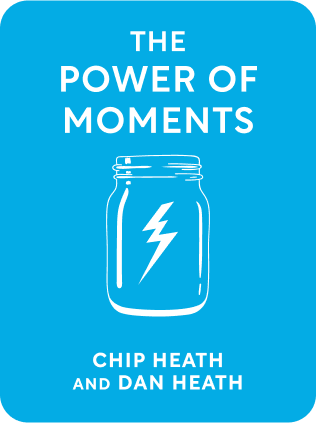

This article is an excerpt from the Shortform book guide to "The Power of Moments" by Chip Heath and Dan Heath. Shortform has the world's best summaries and analyses of books you should be reading.
Like this article? Sign up for a free trial here .
Why is it important to build strong bonds amongst your team members? What is the best way to increase team bonding in your organization?
The importance of team bonding cannot be underestimated: it helps team members become closer, build trust, and strengthen team cohesion. Team bonding happens in situations that create a shared meaning for everyone present—experiences that underscore a common mission. Creating such moments is a three-step process: 1) create a shared moment, 2) allow for voluntary struggle, and 3) reconnect members with their work’s meaning.
Let’s explore each step in more detail.
Step #1: Create a Shared Moment
It’s human nature to constantly tune into the responses and emotions of a group and compare them to our own, synchronizing our reactions to the group’s.
Many of our natural defining moments—weddings, graduations, bar mitzvahs—have a built-in social aspect because they’re reasons to gather. The Heaths stress that engineered defining moments, if they are to be as meaningful as these natural moments, need a similar built-in social aspect that allows group members to bounce their emotions off one another.
Creating a shared moment is your organization’s opportunity to build a meaningful, memorable peak into the general flatness of your members’ everyday tasks. Gathered together, they’re met with the social reality of their impact and are surrounded by like-minded people that make them feel excited, supported, and connected to the cause. It’s just not possible to capture this energy and convey the magnitude of an organization or movement via email.
| The Importance of Team Bonding in Remote Work Dynamics Organizations across the world are increasingly turning to remote work as an option for their employees, but this presents a serious motivational challenge due to the lack of shared moments. Researchers find that most employees don’t find this setup appealing—in fact, they found a significant decline in job satisfaction and employee motivation among remote workers. Many employees attribute this to a lack of social contact: Without the opportunity to meaningfully collaborate and chat with colleagues or see the impact of their work on clients, the work experience becomes endless, disengaging flatness. Though you may not be able to create an in-person shared moment for your remote employees, the following tips can help you work on creating a sense of belonging similar to that fostered by shared moments: Allow autonomy: Once a remote employee has proven their ability to deliver on your expectations, give them the same amount of autonomy that you’d give to any of your office employees. This helps them feel like a true part of the team, rather than an outsider who needs babysitting. Include everyone: Many remote employees work in different time zones. Be mindful of everyone’s work hours and ensure that decisions aren’t made until everyone has had an opportunity to log in and give their input—this reinforces the idea that remote employees are as important to the team as office employees. Send packages: Remote employees are used to doing most of their work via email, so getting a piece of physical mail—such as a thank you note or a package of company goods—is a delightful surprise that reminds them that they’re a valuable part of the team. Set up ways to “mingle”: Remote employees don’t have the opportunity to chat around the water cooler like office employees, so make sure they have spaces to casually chat and get to know one another—such as virtual lunches or coffee breaks or Slack channels dedicated to fun chatter. |
Once you’ve created a shared moment that lends social reality to your members’ efforts, you can build on it by offering up an opportunity for voluntary struggle.
Step #2: Allow for Voluntary Struggle
The Heaths explain that groups bond quickly when they face adversity together. You can see examples of this everywhere: Your chemistry study group becomes close friends after many all-nighters at the library. Fraternity hazing is a month of hell in exchange for brotherly bonds among your pledge class.
(Shortform note: Shared struggle is a powerful bonding tool—the Heaths discuss how it might bring together people who are already part of the same group, but studies have shown that pain or struggle enhances bonding in groups of people without any shared identity. Part of the reason for this is that struggle naturally forces group members to ask for help and show vulnerability, which is a foundational element of relationship-building.)
The Heaths caution that you can’t give your organization members just any struggle with the expectation that they’ll feel motivated and connected to your cause as a result. They suggest inviting group members to the voluntary struggle. Your invitation should include three elements:
- Participation as a choice: There’s no sense of obligation to join—members join solely because they want to, and there is no punishment for deciding not to participate.
- Autonomy: Participants can make their own decisions regarding their work.
- Meaningful mission: The members’ struggle is connected to a larger sense of meaning.
This last point merits deeper exploration, as creating connections to the work itself, rather than just between the people involved, is the third step to strengthening group connections.
Strategy #3: Reconnect Members With Their Work’s Meaning
No matter how excited you are about the cause you’re working for, it’s all too easy to forget your work’s meaningful big picture among the flatness of your day-to-day tasks. The Heaths urge you to strengthen a group’s connection to the meaning of their work by focusing on cultivating their sense of purpose rather than trying to channel their passion.
Your passion, your enthusiasm and excitement for the work at hand, is certainly not a bad thing. It is, however, very individualistic: Your enthusiasm depends largely on who you are as a person and how much you enjoy the type of work you’re doing. Because it’s experienced alone and depends on the enjoyment of the work, passion can easily burn out when the work gets boring or the cause is meeting too many obstacles.
Purpose, on the other hand, is a strong motivator—especially in a group setting. Purpose is rooted in the feeling that your efforts (even if you don’t particularly enjoy them) have an impact or some sort of meaning in something much larger than yourself. Cultivating a feeling of purpose in a group by showing members the impact of their work ties them together in a sense of connection to something meaningful, and allows them to power through dull tasks or endless obstacles.
| The Negative Effect of Chasing Passion In addition to being a poor motivator, there’s no evidence that passion is a route to happiness. Most people believe that the only way to find a job you truly enjoy is to find your passion and follow it. This advice has been mainstream for years, and acts as the starting point for many career books such as Richard Bolles’s What Color Is Your Parachute? However, others argue it’s not good advice. The “passion hypothesis” has caused a decline in workplace satisfaction over the years: Studies cited in Cal Newport’s So Good They Can’t Ignore You show that only 45% of Americans report being happy with their jobs, likely because they feel that they should be doing something that aligns with their passions. |
Example: GreenSpace Volunteer Rally
To better understand how shared moments, voluntary struggle, and a meaningful mission can come together in a successful moment of connection, let’s look at the example of GreenSpace.
GreenSpace (GS) is an organization that builds and maintains parks, playgrounds, and community gardens for underserved neighborhoods and schools in Detroit. They rely heavily on the work of volunteers for myriad tasks. When volunteers started putting in half the hours they used to, GS decided to create a defining moment that would reconnect volunteers with their mission.
Step 1: Create a Shared Moment
The GS founder went all out pulling together a volunteer rally. He rented out the Detroit Institute of Art; he filled the temporary exhibition gallery with photographs of people enjoying GS parks; he bussed in volunteers from all corners of the city; he hired caterers to make appetizers with vegetables from GS community gardens.
Step 2: Reconnect Volunteers with the GS Mission
The founder gave a speech about the triumphs of GS so far, current struggles, and goals moving forward. Then, an 18-year-old woman spoke about her experience growing up in Detroit and spending time in the safe space of a GS park and then revealed that she’ll be studying urban planning at university. The energy of the volunteers was palpable—being in a crowd of excited, like-minded people reignited volunteers’ passion for the work.
Step 3: Allow for Voluntary Struggle
To help with his goals, the founder presented the idea of a new Community Task Force. If interested, volunteers could sign up to run community events to advertise GS’s work and mission, recruit new volunteers, and regularly survey community members for feedback and new ideas. At the end of the rally, there were 200 volunteers signed up for the Community Task Force.

———End of Preview———
Like what you just read? Read the rest of the world's best book summary and analysis of Chip Heath and Dan Heath's "The Power of Moments" at Shortform .
Here's what you'll find in our full The Power of Moments summary :
- How to make everyday experiences meaningful and memorable
- A look at the four elements that create meaning
- How your senses can play a role in elevating everyday moments






